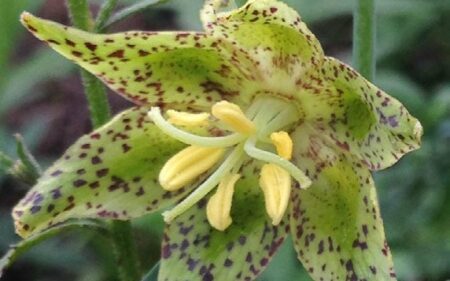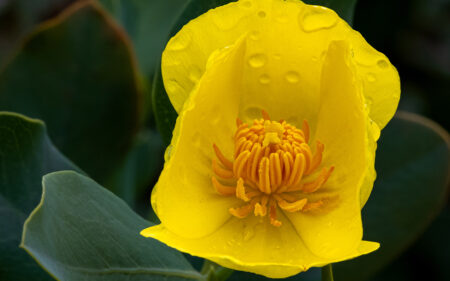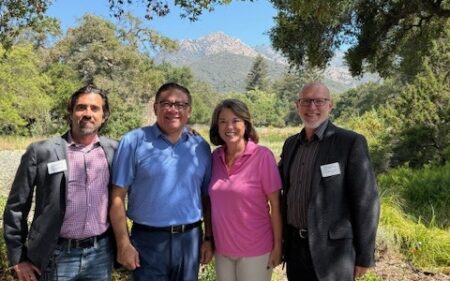The Garden’s Native Lawn Laboratory
The lawn at the Pritzlaff Conservation Center (PCC) sees thousands of visitors and serves as a heavily used event space every year — from personal picnics to private wedding receptions. Due to this impact, we are always striving to find a balance that is both beautiful and functional.

Since its unveiling in 2016, the lawn at the PCC has been divided into three zones: the large blue grama (Bouteloua gracilis) lawn to the north, the bent grass (Agrostis pallens) lawn or various other turf iterations in the middle, and the clustered field sedge (Carex praegracilis) lawn to the south. Throughout a normal year, all three are open to visitors nearly every single day, incurring much heavier usage than the average home lawn. The increased stress and soil compaction from heavy usage resulted in reduced vigor, increased weeds, and poor drainage over time. In spring 2025, the Garden’s horticulture team determined that the poor performance and health of the Bouteloua and Agrostis lawns warranted a large renovation. Our Carex lawn, being further away from the PCC, was not showing the same stress, so this plot remained open for normal use.
Prepping the Space
In early March 2025, the two lawn sections to be renovated were closed and scraped of all vegetation and root matter, by tractor and several horticulture staff with hand tools. Within the large Bouteloua lawn, scraping necessitated the removal of the underlying gopher wire that had spanned the whole lawn to properly till and amend the soil. Over time, we had observed that the soil and root mass above the gopher wire were thinning, and the wire was thus sitting too shallow. This made weeding and aeration very difficult and aggravated compaction. Even with a heavy presence of gophers and moles in the Garden, we decided that removal would be worth the risk for enhanced lawn growth going forward.
The soil left after scraping the grass and wire was a heavily compacted, hard clay that left us worried about drainage and root penetration. As a result, we ran a large 16-hp tiller over the plots several times, removing large clumps of clay and rocks as we progressed. Using a larger machine, we were able to till just about 1 foot deep. After a rough grading of the tilled soil, we brought in about a half inch of washed sand and two to three inches of a 50/50 topsoil-compost mix to replace the material removed. Hoping the sand would aid in drainage, it was put down first and used to fill in low spots and larger pore spaces. The topsoil mix was our final layer, which was smoothed out to a more precise final grade. The lighter, fluffier texture of the topsoil/compost would be crucial for providing the best soil texture to germinate seeds successfully.
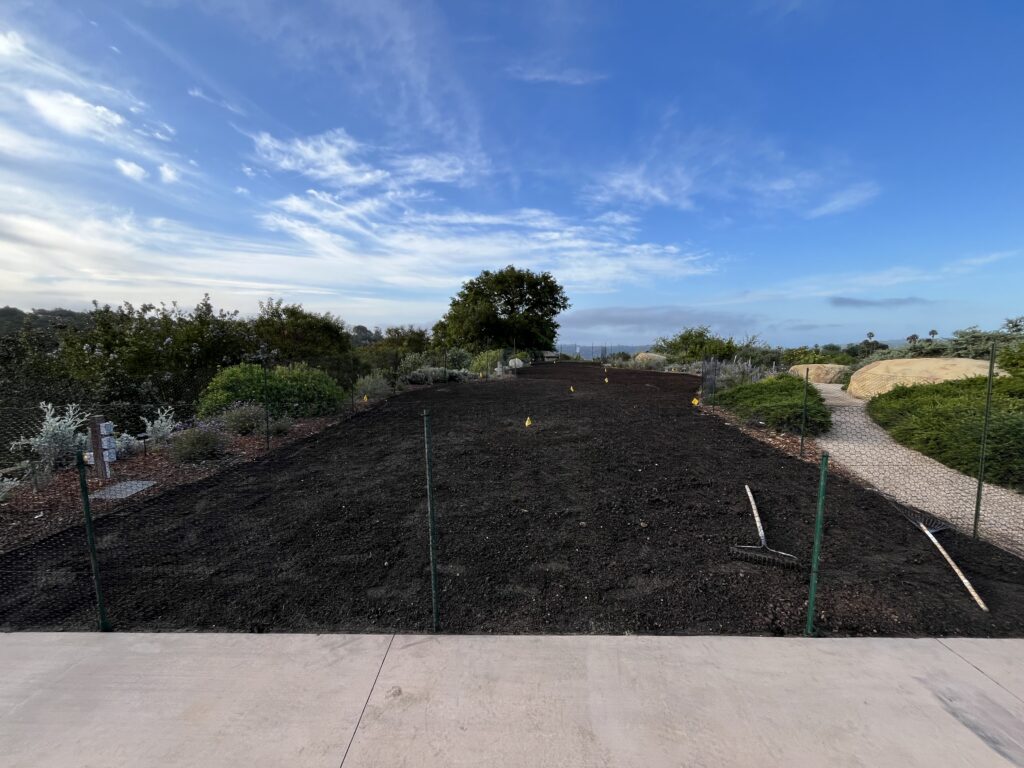
Seeding the Lawn
By late March, we were ready to seed both lawn sections. Bouteloua gracilis has germinated quickly and performed well for us in the past, so we were confident that it could be restored in the large section with little trouble. The middle lawn section was last planted with Agrostis pallens, but we were having trouble keeping it healthy with such heavy foot traffic. It is also a cool-season grass that looks stressed during our most demanding summer season. We saw this as an opportunity to trial a new approach — a polyculture mix of warm-season grass (Aristida purpurea), cool-season grass (Agrostis pallens, Melica imperfecta, Festuca rubra), and a small forb (Achillea millefolium). Our intention was to increase the lawn’s resilience by letting multiple species pick up the slack if one was experiencing stress or dormancy.
Seed was distributed in both plots with washed sand, very lightly raked in, then carefully irrigated over the next several weeks. Throughout this whole process, the lawn remained closed to eliminate foot traffic that could disturb germination of our newly sown seeds, damage new seedlings, or leave divots in the freshly graded soil.
For the first few months, we were seeing some germination of the Bouteloua gracilis, but not at the rate that we had anticipated or seen before. Seedlings were not getting larger, and many were quickly yellowing. The polyculture mix only saw germination of Achillea millefolium, which grew in sparse patches. Seeding in both lawn sections was repeated about five more times into the summer months. The cool, dark, and damp spring conditions we were experiencing were noticeably not ideal for germination, and the birds were finding the seed to be a convenient meal. By continuing into the early summer months, we hoped to get new seeds on the ground as ground and air temperatures shifted to more favorable conditions.
The Bouteloua did fill in slightly with continued seedings but never increased in vigor. Some patches remained bare, and most of the grass remained yellow and stressed. We were also seeing a noticeable increase in weeds that were uncommon or had never been seen before in the Garden, including some typically found in wetlands or salt marshes. We intended to have the lawn fully open and accessible for the summer season, but we were forced to only open it for special events to avoid the additional stress of daily use.
The polyculture mix saw such poor germination that by mid-summer, the decision was made to pivot to a ‘Native Mow-Free’ sod of red fescue (Festuca rubra), Idaho fescue (Festuca idahoensis), and western fescue (Festuca occidentalis). This particular mix fits our coastal climate and can tolerate some foot traffic. Switching to sod rolls allowed us to achieve full coverage immediately and continue using the middle lawn plot throughout our busy event season.
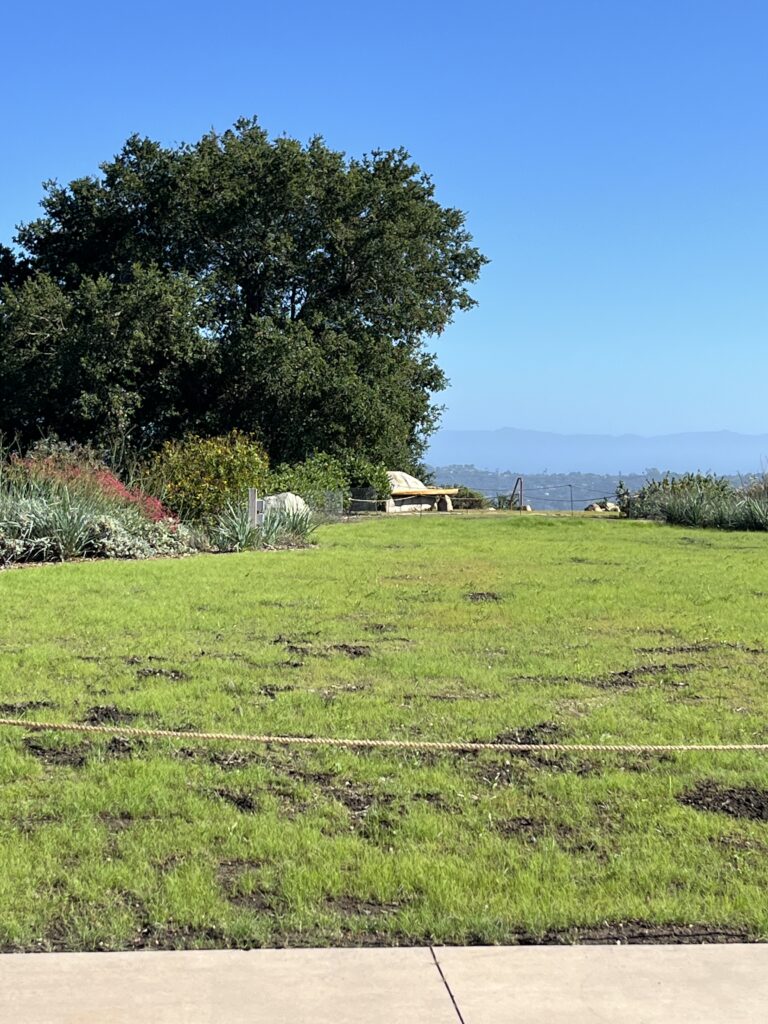
Uncovering Challenges & Applying Solutions
The results of a soil test eventually provided some clarity about what was happening underground to cause our overall poor results. Tests indicated very high sodium, high pH, low nitrogen, and low organic matter. None of these results is desirable for typical gardening applications. The most concerning result was the high sodium saturation. Some plants can adapt to sodic soils, but germinating seeds in these conditions is very difficult. High sodium can harm microorganisms, negatively impact soil structure, make it difficult for plants to absorb water, and lead to nutrient imbalance. High, or alkaline, pH is typical of sodic soils, and when pH trends too high or too low (acidic), certain nutrients become ‘locked up’ or unavailable to plants. The low germination, overall yellowing, and even the exotic weeds were a visually obvious reflection of these conditions. The site pre-renovation did not display stress in the same way, so it was determined that the soil changes during renovation likely contributed to these results.
As we move forward in establishing this lawn, there will be long-term treatments necessary to remediate the soil. We began with a treatment of granular gypsum (calcium sulfate), which helps displace sodium ions, allowing it to be leached out with heavier waterings. Because our lawn is still in use, we are unable to till amendments deeper into the soil and are using a core aerator to create pockets deeper in the soil for amendments. To add organic matter and aid microbial activity, we have also been adding a compost topdressing, applying compost tea (both produced from Garden-made compost), and applying organic fertilizers such as kelp, feather meal, and fish emulsion. Since treatment began, the Bouteloua lawn is appearing greener, but we will need to continue overseeding to see if germination and growth improve over time. To supplement the seed and to fill in larger open gaps, plugs are being planted to create a more uniform lawn. Since these plants are already established, they are stronger and more tolerant of the soil’s current condition.
The middle fescue sod section will remain through summer event season, but it will ultimately be removed and converted to Carex praegracilis (to combine with the existing south Carex section) this winter. We have found that this species tolerates our foot traffic well and spreads quickly by rhizomes. When the sod is removed, we will replace and amend the soil in that plot to start a fresh planting with Carex plugs and seed. The fescue sod will then be relocated to the Garden’s Home Demonstration Section, on the north side of the Cottage, where it is expected to perform best in a more shaded environment.
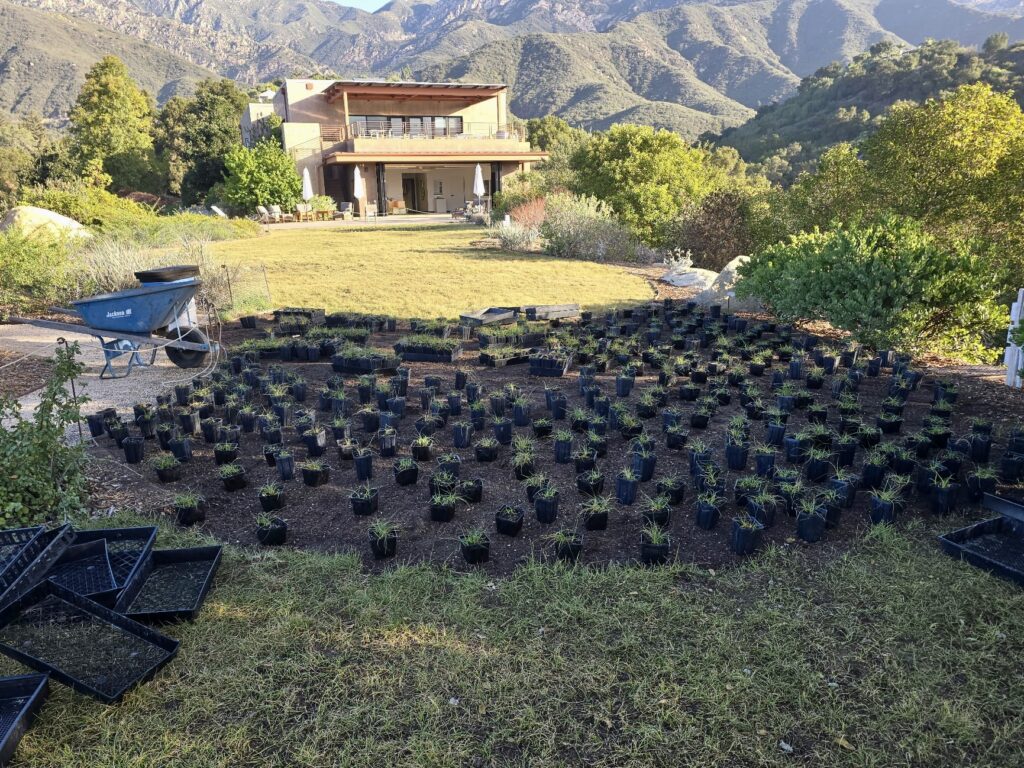
Commitment to Native Lawn Alternatives
While our original polyculture plans did not materialize for this year’s renovation, we are in the process of creating trial plots to continue experimenting with native lawn mixes and ground covers (without the pressure of daily foot traffic and events) in the seasons ahead.
The Garden has been growing native grasses and demonstrating native lawns for many years, and we will continue to use our space as a resource to educate visitors about what is possible with native plants in their own yards. If you’re interested in comparing a well-established Bouteloua gracilis lawn that sees minimal foot traffic, be sure to visit the south side of the Garden’s Home Demonstration Section. Or, if you prefer a wilder look, stop by the iconic Meadow as you enter the Garden.
The Garden is always evolving. Come visit and follow along!
 Donate
Donate